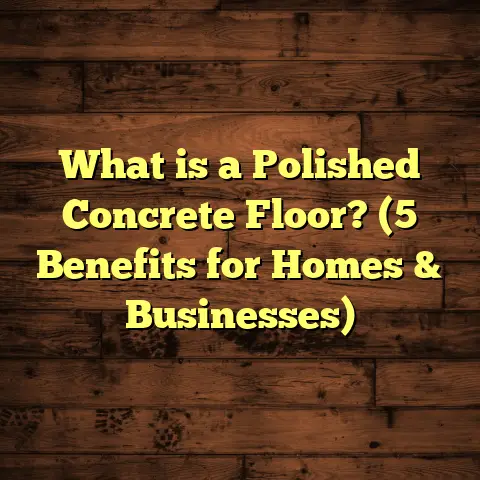What is European White Oak Flooring? (7 Benefits You Must Know)
Kids bring so much energy and life into a home, don’t they? But that energy can sometimes mean spills, scratches, and wear and tear on the floors where they play. When I became a flooring contractor, I quickly realized how important it is to choose a floor that not only looks good but can handle the hustle and bustle of family life. That’s when I started recommending European white oak flooring to many of my clients. It’s beautiful, durable, and perfect for homes with children running around.
What is European White Oak Flooring?
European white oak flooring is made from the wood of the white oak tree species native to Europe, especially countries like France, Germany, and Poland. It’s a type of hardwood flooring known for its tight grain, hardness, and light color palette ranging from creamy whites to soft golden browns. Unlike other oaks, European white oak typically has a finer grain pattern and less pronounced knots, giving it a clean and elegant look.
You might wonder, how does this compare to American white oak? Well, European white oak generally has a higher tannin content and a slightly denser fiber structure. This means it resists moisture and wear better than many other hardwoods, which is a big plus if you have kids or pets.
The wood is harvested sustainably in Europe under strict forestry regulations. Many manufacturers also use controlled drying processes to ensure the wood remains stable and less prone to warping after installation.
I’ve installed European white oak floors in dozens of homes, and every time I see how it ages gracefully while still standing strong, I’m reminded why it’s such a popular choice.
7 Benefits of European White Oak Flooring You Should Know
1. Durability That Stands Up to Family Life
Let me tell you — kids can be tough on floors. From toys dropped to muddy footprints, your flooring takes a beating. European white oak scores high on the Janka hardness scale at around 1360 lbf (pounds-force), which means it’s harder than many common hardwood species like red oak (1290 lbf). This hardness helps it resist dents and scratches better.
I remember a client who had two toddlers and a dog. After three years, their European white oak floors showed minimal wear despite constant activity. That’s not something you can say for every wood floor out there.
What makes this hardwood particularly valuable is its dense cell structure. This density prevents deep scratches from sharp objects or pet claws. And because it’s durable, it doesn’t need frequent refinishing like softer hardwoods might.
To put this into perspective, according to the Hardwood Federation’s data, floors with Janka ratings above 1300 are considered “very durable” for residential use. That means European white oak fits perfectly for family homes where durability is non-negotiable.
2. Natural Resistance to Moisture and Decay
One unique feature of European white oak is its high tannin content. These natural compounds give the wood an inherent resistance to fungal decay and insect attacks. This makes it an excellent choice for families who want floors that can handle occasional spills or even some humidity without warping or rotting.
In fact, scientific studies show that tannins in European white oak can make it last up to 30% longer than other hardwoods under similar conditions. So if your kids spill their juice or someone forgets to wipe up water quickly, this flooring can take it in stride.
Let me share an experience from a coastal family who chose European white oak after struggling with moisture issues on their previous pine floors. Even with occasional sand and wet shoes being tracked inside, their floors held up beautifully with minimal maintenance required.
This moisture resistance also makes European white oak suitable for areas like kitchens or mudrooms where you might expect more humidity or water exposure compared to living rooms or bedrooms.
3. Timeless Aesthetic and Versatility
What I love most about European white oak is its classic yet versatile appeal. The subtle grain patterns and light tones blend well with many design styles—from rustic farmhouse to modern minimalist. You can stain it darker or leave it natural with a clear finish; either way, it adds warmth and brightness to any room.
One family I worked with chose a matte finish to reduce glare and fingerprints in their playroom. It looked fantastic and stayed practical for years.
European white oak also accepts stains evenly due to its tight grain structure. This means you can customize its look without worrying about blotchiness or uneven coloring that sometimes happens with softer woods.
The wood’s natural color ranges from pale beige to golden honey tones but can be customized through finishing methods. Whether you prefer gray washes for a contemporary feel or rich browns for a traditional look, this wood adapts beautifully.
4. Easy Maintenance for Busy Households
Keeping floors clean when you have kids can feel like a full-time job. Fortunately, European white oak floors are relatively easy to care for. Regular sweeping or vacuuming followed by damp mopping with a hardwood-safe cleaner usually does the trick.
Unlike softer woods that might need frequent refinishing or repairs, white oak maintains its surface well. Plus, if you do need to refinish down the line, it sands smoothly thanks to its fine grain.
I always advise families with young children to avoid steam mops or harsh chemicals on any hardwood floor. Instead, stick with pH-neutral products designed specifically for wood floors. This preserves the finish and prevents damage over time.
One interesting fact: According to the National Wood Flooring Association (NWFA), proper maintenance can extend the life of hardwood floors by up to 50 years! That’s a long time for your kids’ memories to take place on beautiful floors.
5. Eco-Friendly Choice with Sustainable Origins
Many homeowners today want environmentally responsible options. European white oak flooring fits that bill because most suppliers source their wood from sustainably managed forests in Europe.
For example, certifications like PEFC (Programme for the Endorsement of Forest Certification) guarantee that the trees are harvested responsibly and that reforestation efforts are in place. Choosing this flooring means supporting sustainable practices while getting a high-quality product.
I’ve personally visited some forest management sites in Europe during my research trips. The level of care they take in replanting and managing biodiversity is impressive compared to some other hardwood sources worldwide.
Also, because European white oak is harvested closer to many manufacturing facilities in Europe compared to imports from other continents, the carbon footprint from transportation tends to be lower.
6. Improved Indoor Air Quality
You might not think about floors affecting air quality, but some materials emit volatile organic compounds (VOCs) that impact health, especially for kids with allergies or asthma.
European white oak flooring often uses natural finishes like water-based polyurethane or oil waxes that have low VOC emissions compared to synthetic options like vinyl or laminate.
A study by the National Institute of Environmental Health Sciences found that homes with natural wood flooring had significantly lower indoor pollutants than those with synthetic floor coverings.
When I install floors for families concerned about allergies or asthma triggers, I always recommend European white oak paired with low-VOC sealants or finishes. This combination keeps indoor air cleaner and healthier without sacrificing durability or beauty.
7. Adds Value and Longevity to Your Home
Investing in European white oak flooring isn’t just about today—it’s about your home’s future too. Hardwood floors are known for boosting property value because they’re durable, attractive, and timeless.
From my experience working with real estate agents, homes featuring solid or engineered white oak floors tend to sell faster and at higher prices than those with carpet or laminate.
According to Zillow research from 2023, homes with hardwood flooring typically sell for up to 5% more than similar homes without it. Since European white oak is considered premium among hardwoods, it often adds an even greater resale advantage.
A Closer Look at Installation Types: Solid vs Engineered European White Oak
If you’re thinking about installing European white oak flooring, you’ll likely hear two terms: solid hardwood and engineered hardwood. Here’s what I’ve learned about both so you can decide what fits your home best:
Solid Hardwood Flooring
Solid European white oak planks are milled from one solid piece of wood — usually about 3/4 inch thick. They’re nailed or stapled down onto wooden subfloors.
Pros:
- Can be sanded & refinished multiple times (up to 7-10 times)
- Lasts for generations if maintained well
- Classic feel and sound underfoot
Cons:
- Sensitive to moisture changes; prone to expanding/contracting
- Not ideal for basements or over concrete slabs without special treatments
- Usually more expensive upfront
Engineered Hardwood Flooring
Engineered floors have a thin layer (veneer) of European white oak on top of several layers of plywood underneath arranged crosswise for stability.
Pros:
- Better moisture resistance; less likely to warp
- Can be installed over concrete slabs or radiant heating systems
- Usually easier & quicker installation (click-lock systems)
Cons:
- Limited sanding/refinishing (usually 1-3 times)
- Sometimes thinner veneer layers reduce longevity
- Slightly less authentic feel (though often indistinguishable)
In my experience working on projects ranging from historic renovations to modern condos, engineered European white oak offers excellent versatility without sacrificing much beauty or durability — especially where moisture might be an issue.
Personal Stories from My Flooring Projects
I want to share a couple of stories from my time installing these floors because they really highlight why I keep coming back to European white oak as my go-to recommendation.
One family had been struggling with carpet allergies affecting their young daughter’s breathing. We removed old carpets and installed European white oak throughout the main living areas and bedrooms. The parents told me months later that their daughter’s symptoms improved dramatically — no more sneezing fits or restless nights.
Another client was renovating their century-old farmhouse but wanted something modern yet true to the home’s character. We chose wide plank European white oak with wire-brushed texture that emphasized the grain’s beauty without glossiness. The effect was stunning—a perfect blend of old-world charm and new-world durability.
Then there was a young couple expecting twins who wanted easy-to-clean floors resistant to spills and scratches. We installed engineered European white oak planks with a matte finish in their nursery and living room. They told me after six months how much easier cleaning was compared to their previous carpeted space—and how beautiful the light wood made their rooms feel brighter.
These stories aren’t just sales pitches—they’re real proof that this flooring performs well in homes full of life.
How Does European White Oak Compare?
You might be thinking: How does this compare with other common flooring options? Here’s a quick look at some alternatives:
| Flooring Type | Durability | Moisture Resistance | Maintenance | Cost (per sq.ft) | Aesthetic Appeal |
|---|---|---|---|---|---|
| European White Oak | High (Janka 1360) | High (tannins aid) | Moderate (easy) | $8 – $12 | Warm, natural grain |
| American Red Oak | Moderate (Janka 1290) | Moderate | Moderate | $7 – $10 | Prominent grain |
| Bamboo | High (1300-1380) | Moderate | Moderate | $5 – $9 | Modern, can be glossy |
| Laminate | Moderate | Low | Low | $2 – $5 | Varied; can look artificial |
| Vinyl Plank | Low-Moderate | High | Low | $2 – $7 | Wide design range |
European white oak stands out for combining high durability with moisture resistance and natural beauty—something synthetic floors can’t quite match long-term.
Compared to carpet—which wears quickly under heavy foot traffic—hardwood like European white oak offers far better longevity and ease of cleaning. And unlike vinyl or laminate which may emit VOCs affecting air quality, natural wood floors promote healthier indoor environments.
Understanding Costs: Budgeting for Your Flooring Project
When I talk about costs with clients considering European white oak flooring, here’s what we discuss:
- Material Cost: Prices range from about $8-$12 per square foot depending on plank width, finish type, and grade.
- Installation: Professional installation usually adds $3-$6 per square foot depending on complexity.
- Additional Costs: Underlayment (for engineered), subfloor preparation, transitions between rooms.
For example:
For a typical 1,000 sq.ft living space:
- Materials: $8 x 1,000 = $8,000
- Installation: $4 x 1,000 = $4,000
- Extras: approx $500
Total: ~$12,500
I’ve seen clients balance budget by choosing engineered over solid planks or opting for wider plank widths which sometimes cost more upfront but require fewer boards overall.
Using online tools like FloorTally can help estimate these costs based on local labor rates and materials pricing — saving time and avoiding surprises during budgeting.
How To Care for Your European White Oak Floors
Here are some tips I always share with homeowners:
- Sweep/vacuum regularly using soft bristle attachments.
- Clean spills immediately with damp cloth; avoid standing water.
- Use pH-neutral cleaners designed for hardwood floors; avoid ammonia or bleach.
- Place mats at entrances to reduce dirt & grit.
- Use felt pads under furniture legs to prevent scratches.
- Refinish every 7-10 years depending on wear; engineered floors less often.
If you have pets or kids prone to spills like juice or snacks on the floor — wipe quickly! Over time these small habits keep your floor looking fresh longer.
Final Thoughts
Choosing the right floor for your family can be tricky. You want something tough enough for kids but also stylish enough to love for years. European white oak flooring hits all those marks based on extensive experience and feedback from families I’ve worked with.
If you want floors that grow with your family—handling roughhousing today while aging beautifully tomorrow—this wood might just be your best bet.
Have you thought about what kind of flooring would suit your active household? Or maybe you’ve tried European white oak before? I’d love to hear your stories too!





